Related Research Articles

A guitar amplifier is an electronic device or system that strengthens the electrical signal from a pickup on an electric guitar, bass guitar, or acoustic guitar so that it can produce sound through one or more loudspeakers, which are typically housed in a wooden cabinet. A guitar amplifier may be a standalone wood or metal cabinet that contains only the power amplifier circuits, requiring the use of a separate speaker cabinet–or it may be a "combo" amplifier, which contains both the amplifier and one or more speakers in a wooden cabinet. There is a wide range of sizes and power ratings for guitar amplifiers, from small, lightweight "practice amplifiers" with a single 6-inch speaker and a 10-watt amp to heavy combo amps with four 10-inch or four 12-inch speakers and a 100-watt amplifier, which are loud enough to use in a nightclub or bar performance.

Marshall Amplification is a British company that designs and manufactures music amplifiers and speaker cabinets. Founded in London by shop owner and drummer Jim Marshall, the company is based in Bletchley, Milton Keynes, England. Since March 2023, Marshall Amplification has been one of several divisions of the Swedish conglomerate, the Marshall Group.
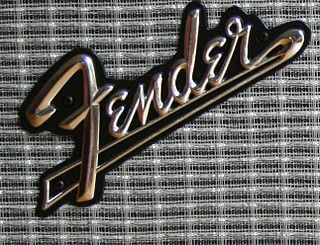
Fender amplifiers are electric instrument amplifiers produced by the Fender Musical Instruments Corporation. The first guitar amplifiers attributed to Leo Fender were manufactured by the K&F Manufacturing Corporation (K&F) between 1945 and 1946. Later, Fender began building its own line of electric guitars. Fender amplifiers would become favorites of guitarists like Jimi Hendrix, Eric Clapton, and Stevie Ray Vaughan, also known in these cases for playing Fender guitars.
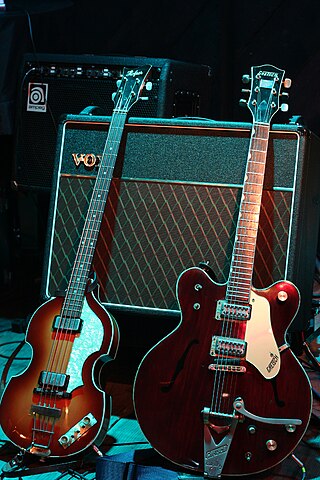
The Vox AC30 is a guitar amplifier manufactured by Vox. It was introduced in 1958 to meet the growing demand for louder amplifiers. Characterised by its "jangly" high-end sound it has become widely recognized by British musicians and others, such as George Harrison and John Lennon of the Beatles, Bill Wyman of the Rolling Stones, Brian May of Queen, Dave Davies of the Kinks and Hank Marvin.

A bass amplifier is a musical instrument electronic device that uses electrical power to make lower-pitched instruments such as the bass guitar or double bass loud enough to be heard by the performers and audience. Bass amps typically consist of a preamplifier, tone controls, a power amplifier and one or more loudspeakers ("drivers") in a cabinet.

The Fender Twin and Twin Reverb are guitar amplifiers made by Fender Musical Instruments Corporation. The Twin was introduced in 1952, two years before Fender began selling Stratocaster electric guitars. The amps are known for their characteristically clean tone.
AHED was a Canadian company owned by Phil G. Anderson that produced guitar amplifiers, as well as guitars. Its main product line was the GBX amplifier, which could reach 180 watts with 4x10", 4x12" or 2x15" speakers. The GBX amplifier had a pre-amplifier that could change the gain, brilliance, depth, contour and response of the output.

The Fender Hot Rod Deluxe is a guitar amplifier manufactured and sold by the Fender Musical Instruments Corporation. It was introduced in 1996 as part of the "Hot Rod" line of guitar amplifiers and has been in continuous production since. The Hot Rod Deluxe is a modified version of the Fender Blues Deluxe from the earlier Blues line of amplifiers, and has a higher level of gain in its preamplification signal. This model, along with the Hot Rod Deville, were originally designated as F.A.T. amplifiers but this moniker was dropped in 2002 when production of this series of amps was moved from Corona, CA to Fender's Baja-Ensenada, Mexico manufacturing facility.
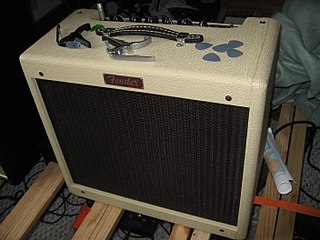
The Blues Junior is a tube guitar amplifier introduced in 1995 by the Fender Musical Instrument Corporation. It is aimed at achieving the warm, tube-driven tone common in many styles of American blues and blues rock dating back to the 1950s, while remaining both portable and affordable. A popular amp, Fender have released numerous versions since its initial release, the most recent being the version IV in 2018. Fender also frequently releases limited editions of the Blues Junior, such as the Lacquered Tweed and the "80 Proof".

The Fender Bassman is a series of bass amplifiers introduced by Fender during 1952. Initially intended to amplify bass guitars, musicians used the 5B6 Bassman to amplify other instruments, including electric guitars, harmonicas, and pedal steel guitars. Besides being a popular and important amplifier in its own right, the Bassman also became the foundation on which Marshall and other companies built their high-gain tube amplifiers.

The Fender Super Reverb is a guitar amplifier made by Fender. It was originally introduced in 1963 and was discontinued in 1982. The Super Reverb was a Fender Super amplifier with built-in reverb and "vibrato". The original Super Reverb amplifiers were all-tube designs and featured spring reverb. There were two different designs, distinguishable by the color of the "face" or front control panel. Super Reverbs from 1963 through 1967 had "blackface" panels. From 1968 until its discontinuation in 1982, the Super Reverb had "silverface" cosmetics and circuitry. Early models in 1968, while cosmetically "silverface", did contain "blackface" circuitry. Fender introduced a reissue '65 Super Reverb in 2001 featuring a printed circuit board design rather than the hand-wired circuitry of the original '65 Super Reverb.

The Fender Hot Rod DeVille is a combo tube guitar amplifier manufactured and sold by Fender. It was introduced in 1996 as part of Fender's Hot Rod line of amplifiers, and since then has been in continuous production. The Hot Rod DeVille is a modified version of the earlier Fender Blues DeVille from the Blues amplifier line and has a higher level of gain in its preamplification signal. The DeVille incorporates a 60 watt amplifier and has been offered in two different models: a 212, with 2, 12-inch speakers and a 410, with 4, 10-inch speakers. The 410 utilized 10" Fender Special Design speakers made by Eminence and was available for versions II and III. The 212 has been available through versions II, III and IV. The 212 has offered the following speakers: 12" Fender Special Design by Eminence for version II, 12" Celestion G12-P80 for version III, and 12" Celestion A-Type for version IV. Fender described version III as incorporating modifications to the preamp to provide the drive channels with "more modern distortion," switching to Celestion speakers for the 212, and changing the control panel from chrome to black, for better visibility on stage. Fender described version IV as incorporating modifications to the preamp to provide the drive channels with "better definition of the notes," changing the type of Celestion speaker, and modifying the reverb unit to provide "smoother" and more controllable reverb. The DeVille is the sister amplifier of the Fender Hot Rod Deluxe.
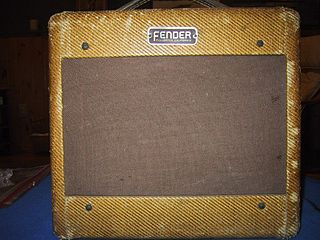
The Fender Champ was a guitar amplifier made by Fender. It was introduced in 1948 and discontinued in 1982. An updated version was introduced in 2006 as part of the "Vintage Modified" line.
The Fender Bandmaster Reverb was a tube amplifier made by Fender. It was primarily a Silverface Bandmaster piggyback 'head' with the addition of reverb and vibrato and a modified circuit that shared more similarities with other Fender amplifiers. It was introduced in 1968 and was discontinued in 1980 .The Bandmaster Reverb was produced in both a 40 watt and 70 watt tube variant, before being reissued as a vintage modified amplifier.

The Fender Princeton Reverb is a guitar amplifier combo. It is based on the Princeton and includes built-in reverb and vibrato.

The Mesa/Boogie Mark Series is a series of guitar amplifier made by Mesa Engineering. Originally just referred to as "Boogies", the product line took on the moniker "Mark Series" as newer revisions were put into production. The Mark Series amplifier was Mesa's flagship product until the introduction of the Rectifier series, and the amplifiers are collectable.
The Fender Deluxe guitar amplifier is a range of non-reverb guitar amplifiers produced by Fender. The amplifiers were originally produced from early 1948 to 1966 and reissues are in current production. Its predecessor was the Fender Model 26 "Woodie" produced from 1946 to 1948.

Roland Jazz Chorus is the name given to a series of solid-state instrument amplifiers produced by the Roland Corporation in Japan since 1975. Its name comes from its built-in analog chorus effect. The Jazz Chorus series became increasingly popular in the late 1970s and early 1980s new wave and post-punk scenes because of its clean yet powerful sound, durability and relatively low cost when compared to the more commonly used tube amplifiers of the time such as Marshall or Fender. It also found favour amongst funk players in America. It also became popular to use for clean tones in heavy metal, with the most famous users being James Hetfield and Kirk Hammett from Metallica, and Wes Borland from Limp Bizkit.

Traynor is a brand of bass amplifiers and guitar amplifiers, the first brand formed by Yorkville Sound. The Traynor brand, named for founder Peter Traynor, began in 1963 with the Dynabass bass amplifier, a rental product. Traynor first became popular in Canada by providing less expensive versions of the circuits used in Marshall and Fender amplifiers of the time. The revived brand now produces a wide range of electric, acoustic, and bass guitar amps.
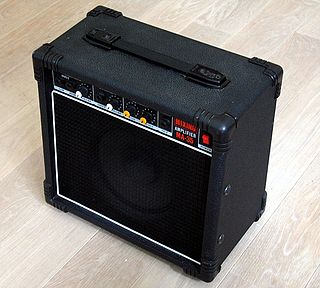
A keyboard amplifier is a powered electronic amplifier and loudspeaker in a wooden speaker cabinet used for the amplification of electronic keyboard instruments. Keyboard amplifiers are distinct from other types of amplification systems such as guitar amplifiers due to the particular challenges associated with making keyboards sound louder on stage; namely, to provide solid low-frequency sound reproduction for the deep basslines that keyboards can play and crisp high-frequency sound for the high-register notes. Another difference between keyboard amplifiers and guitar/bass amplifiers is that keyboard amps are usually designed with a relatively flat frequency response and low distortion. In contrast, many guitar and bass amp designers purposely make their amplifiers modify the frequency response, typically to "roll-off" very high frequencies, and most rock and blues guitar amps, and since the 1980s and 1990s, even many bass amps are designed to add distortion or overdrive to the instrument tone.
References
- ↑ "'65 Twin Custom 15". Fender Musical Instruments Corporation. Retrieved 14 July 2013.